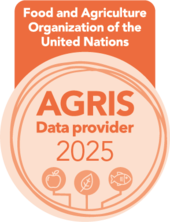Efectos de la co-inoculación de Bioformulados (PGPR´s) sobre el porcentaje de germinación y promover el crecimiento en plántula de papaya (Carica papaya L.)
DOI:
https://doi.org/10.57188/manglar.2023.017Resumen
La latencia es un bloqueo para la germinación y representa un mecanismo adaptativo que permite a la semilla de papaya retrasar su emergencia. Las rizobacterias mejoran el crecimiento de las plantas de diversas formas, la producción de fitohormonas, la fijación de nitrógeno, la solubilización de fosfatos y aumenta la morfología de las raíces. La presente investigación se realizó para determinar la eficiencia de las rizobacterias (PGPR´s) Pseudomona protegens (CHA0) y Pseudomona putida (BMR 2-4) inoculadas dentro de tres bioformulados para ser evaluadas dentro del porcentaje de germinación, incremento de pelos absorbentes utilizando rizotrones y plántulas bajo consorcios o en combinación de fertilizantes fosforados. En condiciones in-vitro la co-inoculación BIOIMPULSE fue muy eficaz para aumentar el porcentaje de germinación con promedio 80%. En rizotrones se exhibieron mayor aumento de pelos absorbentes de 5,67 mm y área de raicillas 0,86 mm2 por BIOIMPULSE comparable al tratamiento expuesto con AIA (25 mg/mL). En plántulas son altamente efectivas para mejorar la morfología de las raíces y altura emendando 5 g/L fosforo se observó dimensiones Ø del hipocótilo entre (5,12 a 4,62 mm) y hojas funcionales (9,75 a 11,75). BIOIMPULSE modifican el funcionamiento de las raíces, mejoran la nutrición de las plantas e influyen en la fisiología vegetativa siendo versátil sobre todos los demás bioformulados por aumentar el porcentaje de germinación, aparición temprana de pelos radicular e incremento radicular en presencia de fertilizantes fosforados. Lo que repercute que pueden ser útiles para reducir el costo de los fertilizantes químicos.
Descargas
Referencias
Adedayo, A. A., Babalola, O. O., Prigent-Combaret, C., Cruz, C., Stefan, M., Kutu, F., & Glick, B. R. (2022). The application of plant growth-promoting rhizobacteria in Solanum lycopersicum production in the agricultural system: A review. PeerJ, 10, e13405.
Adoko, M. Y. E., Agbodjato, N. A., Noumavo, A. P., Amogou, O. E., Adjanohoun, A., & Baba-Moussa, L. (2021). Bioformulations based on plant growth promoting rhizobacteria for sustainable agriculture: Biofertilizer or Biostimulant?. African Journal of Agricultural Research, 17(9), 1256-1260. https://doi.org/10.5897/AJAR2021.15756.
Alara, O. R., Abdurahman, N. H., & Alara, J. A. (2020). Carica papaya: comprehensive overview of the nutritional values, phytochemicals and pharmacological activities. Advances in Traditional Medicine, 22(1), 1-31.
Benítez, S. P., Mario, L., Delgado, O. A., & Medina, C. I. (2013). Estudios de germinación y remoción de latencia en semillas de papayuelas Vasconcellea cundinamarcensis y Vasconcellea goudotiana. Ciencia y Tecnología Agropecuaria, 14(2), 187-197. https://doi.org/10.21930/rcta.vol14_num2_art:407.
Bharathi, R., Vivekananthan, R., Harish, S., Ramanathan, A., & Samiyappan, R. (2004). Rhizobacteria-based bio-formulations for the management of fruit rot infection in chillies. Crop Protection, 23(9), 835-843. https://doi.org/10.1016/j.cropro.2004.01.007.
Cardarelli, M., Woo, S. L., Rouphael, Y., & Colla, G. (2022). Seed Treatments with Microorganisms Can Have a Biostimulant Effect by Influencing Germination and Seedling Growth of Crops. Plants, 11(3), 259. https://doi.org/10.3390/plants11030259.
Carrasco-Fernández, J., Guerra, M., Castro, J. F., Bustamante, L., Barra-Bucarei, L., Ceballos, R., ... & France, A. (2020). Plant growth promoting rhizobacteria from Juan Fernández archipelago improve germination rate of endangered plant Solanum fernandezianum Phil. Chilean journal of agricultural research, 80(1), 41-49. http://dx.doi.org/10.4067/S0718-58392020000100041.
Chandni, B., Kanzaria, D. R., Karmur, N. N., Sandh, M., Parsana, J. S., & Patel, H. N. (2022). Effect of sarcotesta on papaya seedling. The Pharma innovation journal, 11(8), 1412-1415. https://doi.org/10.5772/intechopen.88012.
Chaudhary, T., Dixit, M., Gera, R., Shukla, A. K., Prakash, A., Gupta, G., & Shukla, P. (2020). Techniques for improving formulations of bioinoculants. 3 Biotech, 10(5), 1-9. https://doi.org/10.1007/s13205-020-02182-9.
Donati, A. J., Lee, H. I., Leveau, J. H., & Chang, W. S. (2013). Effects of indole-3-acetic acid on the transcriptional activities and stress tolerance of Bradyrhizobium japonicum. PloS one, 8(10), e76559. https://doi.org/10.1371/journal.pone.0076559.
Ganeshamoorthi, P., Anand, T., Prakasam, V., Bharani, M., Ragupathi, N., & Samiyappan, R. (2008). Plant growth promoting rhizobacterial (PGPR) bioconsortia mediates induction of defense-related proteins against infection of root rot pathogen in mulberry plants. Journal of Plant Interactions, 3(4), 233-244.
Glick, B. R. (2005). Modulation of plant ethylene levels by the bacterial enzyme ACC deaminase. FEMS microbiology letters, 251(1), 1-7. https://doi.org/10.1016/j.femsle.2005.07.030.
Hasani, H., & Aminpanah, H. (2015). Effect of Pseudomonas fluorescens Inoculation on Yield and Yield Components of Rice (Oryza sativa L.) under Different Levels of Phosphorus Fertilizer. Thai Journal of Agricultural Science, 48(3), 157-163.
Jaramillo, M. P., Álvarez, A. E. B., Navarrete, E. D. T., Martínez, H. F. C., Prieto-Encalada, H., & Carriel, J. M. (2016). Producción de ácido indol-3-acético por Pseudomonas veronii R4 y formación de raíces en hojas de vid “Thompson seedless” in vitro. Ciencia y Tecnología, 9(1), 31-36. https://doi.org/10.18779/cyt.v9i1.158.
Jeyanthi, V., & Kanimozhi, S. (2018). Plant growth promoting rhizobacteria (PGPR)-prospective and mechanisms: a review. J Pure Appl Microbiol, 12(2), 733-749. https://dx.doi.org/10.22207/JPAM.12.2.34.
Kalita, M., Bharadwaz, M., Dey, T., Gogoi, K., Dowarah, P., Unni, B. G., ... & Saikia, I. (2015). Developing novel bacterial based bioformulation having PGPR properties for enhanced production of agricultural crops. Indian Journal of Experimental Biology, 53(1), 56-60.
Katiyar, D., Hemantaranjan, A., & Singh, B. (2016). Plant growth promoting Rhizobacteria-an efficient tool for agriculture promotion. Adv Plants Agric Res, 4(6), 426-434.
Keswani, C., Singh, S. P., Cueto, L., García-Estrada, C., Mezaache-Aichour, S., Glare, T. R., ... & Sansinenea, E. (2020). Auxins of microbial origin and their use in agriculture. Applied Microbiology and Biotechnology, 104, 8549-8565.
King, E. O., Ward, M. K., & Raney, D. E. (1954). Two simple media for the demonstration of pyocyanin and fluorescin. The Journal of laboratory and clinical medicine, 44(2), 301-307.
Koul, B., Pudhuvai, B., Sharma, C., Kumar, A., Sharma, V., Yadav, D., & Jin, J. O. (2022). Carica papaya L.: a tropical fruit with benefits beyond the tropics. Diversity, 14(8), 683. https://doi.org/10.3390/d14080683.
Marquina, M. E., Ramírez, Y., & Castro, Y. (2018). Efecto de bacterias rizosféricas en la germinación y crecimiento del pimentón Capsicum annuum L. Var. cacique gigante. Bioagro, 30(1), 3-16.
Martínez-Viveros, O., Jorquera, M. A., Crowley, D. E., Gajardo, G. M. L. M., & Mora, M. L. (2010). Mechanisms and practical considerations involved in plant growth promotion by rhizobacteria. Journal of soil science and plant nutrition, 10(3), 293-319.
Minchev, Z., Kostenko, O., Soler, R., & Pozo, M. J. (2021). Microbial consortia for effective biocontrol of root and foliar diseases in tomato. Frontiers in Plant Science, 2428. http://dx.doi.org/10.4067/S0718-95162010000100006.
Mitra, D., Mondal, R., Khoshru, B., Shadangi, S., Mohapatra, P. K. D., & Panneerselvam, P. (2021). Rhizobacteria mediated seed bio-priming triggers the resistance and plant growth for sustainable crop production. Current Research in Microbial Sciences, 2, 100071. https://doi.org/10.1016/j.crmicr.2021.100071.
Naveed, M., Qureshi, M. A., Zahir, Z. A., Hussain, M. B., Sessitsch, A., & Mitter, B. (2015). L-Tryptophan-dependent biosynthesis of indole-3-acetic acid (IAA) improves plant growth and colonization of maize by Burkholderia phytofirmans PsJN. Annals of microbiology, 65, 1381-1389. https://doi.org/10.1007/s13213-014-0976-y.
Nikfarjam, S. G., & Aminpanah, H. (2015). Effects of phosphorus fertilization and Pseudomonas fluorescens strain on the growth and yield of faba bean (Vicia faba L.). Idesia, 33(4), 15-21. http://dx.doi.org/10.4067/S0718-34292015000400003.
Patten, C. L., & Glick, B. R. (1996). Bacterial biosynthesis of indole-3-acetic acid. Canadian journal of microbiology, 42(3), 207-220. https://doi.org/10.1139/m96-032.
Qessaoui, R., Bouharroud, R., Furze, J. N., El Aalaoui, M., Akroud, H., Amarraque, A., ... & Chebli, B. (2019). Applications of new rhizobacteria Pseudomonas isolates in agroecology via fundamental processes complementing plant growth. Scientific Reports, 9(1), 1-10. https://doi.org/10.1038/s41598-019-49216-8.
Raj, R. D. P., Preethy, H. A., & Rex, K. G. R. (2021). Development of Banana Peel Powder as Organic Carrier based Bioformulation and Determination of its Plant Growth Promoting Efficacy in Rice Cr100g. Journal of Pure and Applied Microbiology, 15(1), 1279-1290. https://doi.org/10.22207/JPAM.15.3.18.
Rodríguez, S., Vargas, I., Hijuelo, A., Loumeto, F., Silva, J. J., Pérez, J., ... & Oliva, D. (2019). Analysis of the effect of scarification process on papaya (Carica papaya Lin.) Seeds Germination. In Seed Dormancy and Germination. IntechOpen. https://doi.org/10.5772/intechopen.88012.
Romero Rodríguez, J. A., Mejía Contreras, J. A., Carballo Carballo, A., López Jiménez, A., Rangel Lucio, J. A., & Ávila Reséndiz, C. (2013). Escarificación química de semilla de papaya. Revista mexicana de ciencias agrícolas, 4(6), 947-954. https://doi.org/10.29312/remexca.v4i6.1162.
Rosa, P. A. L., Mortinho, E. S., Jalal, A., Galindo, F. S., Buzetti, S., Fernandes, G. C., ... & Teixeira Filho, M. C. M. (2020). Inoculation with growth-promoting bacteria associated with the reduction of phosphate fertilization in sugarcane. Frontiers in Environmental Science, 32(8), 1-18. https://doi.org/10.3389/fenvs.2020.00032.
Rueden, C. T., Schindelin, J., Hiner, M. C., DeZonia, B. E., Walter, A. E., Arena, E. T., & Eliceiri, K. W. (2017). ImageJ2: ImageJ for the next generation of scientific image data. BMC bioinformatics, 18(1), 1-26. https://doi.org/10.1186/s12859-017-1934-z.
Saavedra, D. A. C., Martínez, H. F. C., Rosero, N. C., Cuenca, F. F. G., Fernández, R. G., & Moreira, Á. V. C. (2017). Rizobacterias que promueven el desarrollo e incremento en productividad de Glycine max L. Revista Ciencia y Tecnología, 10(1), 7-15. https://doi.org/10.18779/cyt.v10i1.198.
Saidi, A., & Hajibarat, Z. (2021). Phytohormones: Plant switchers in developmental and growth stages in potato. Journal of Genetic Engineering and Biotechnology, 19(1), 1-17. https://doi.org/10.1186/s43141-021-00192-5.
Sharma, N., Manhas, R. K., & Ohri, P. (2022). Streptomyces hydrogenans strain DH-16 alleviates negative impact of Meloidogyne incognita stress by modifying physio-biochemical attributes in Solanum lycopersicum plants. Scientific Reports, 12(1), 15214. https://doi.org/10.1038/s41598-022-19636-0.
Silva, J. D., Rashid, Z., Nhut, D. T., Sivakumar, D., Gera, A., Souza, M. T., & Tennant, P. (2007). Papaya (Carica papaya L.) biology and biotechnology. Tree and Forestry Science and Biotechnology, 1(1), 47-73.
Truyens, S., Weyens, N., Cuypers, A., & Vangronsveld, J. (2015). Bacterial seed endophytes: genera, vertical transmission and interaction with plants. Environmental Microbiology Reports, 7(1), 40-50. https://doi.org/10.1111/1758-2229.12181.
Tsukanova, K. A., Meyer, J. J. M., & Bibikova, T. N. (2017). Effect of plant growth-promoting Rhizobacteria on plant hormone homeostasis. South African Journal of Botany, 113, 91-102. https://doi.org/10.1016/j.sajb.2017.07.007.
Ugoji, E. O., & Laing, M. D. (2008). Rhizotron studies on Zea mays L. to evaluate biocontrol activity of Bacillus subtilis. World Journal of Microbiology and Biotechnology 24, 269-274. https://doi.org/10.1007/s11274-007-9466-8.
Vassileva, M., Malusà, E., Sas-Paszt, L., Trzcinski, P., Galvez, A., Flor-Peregrin, E., ... & Vassilev, N. (2021). Fermentation strategies to improve soil bio-inoculant production and quality. Microorganisms, 9(6), 1254. https://doi.org/10.3390/microorganisms9061254.
Vega-Celedón, P., Canchignia Martínez, H., González, M., & Seeger, M. (2016). Biosíntesis de ácido indol-3-acético y promoción del crecimiento de plantas por bacterias. Cultivos Tropicales, 37, 33-39. https://dx.doi.org/10.13140/RG.2.1.5158.3609
Vidhyasekaran, P., & Muthamilan, M. (1995). Development of formulations of Pseudomonas fluorescens for control of chickpea wilt. Plant disease, 79(8), 782-786. https://doi.org/10.1016/S0261-2194(96)00045-2.
Widawati, S. (2017, November). Effect of plant growth promoting rhizobacteria and molasses on seed germination and seedling growth of Sorghum bicolor L. Moench. In Proceedings The SATREPS Conference (Vol. 1, No. 1, pp. 94-99).
Wong, C. K. F., Saidi, N. B., Vadamalai, G., Teh, C. Y., & Zulperi, D. (2019). Effect of bioformulations on the biocontrol efficacy, microbial viability and storage stability of a consortium of biocontrol agents against Fusarium wilt of banana. Journal of applied microbiology, 127(2), 544-555. https://doi.org/10.1111/jam.14310.
Yang, W. (2019). Components of rhizospheric bacterial communities of barley and their potential for plant growth promotion and biocontrol of Fusarium wilt of watermelon. Brazilian Journal of Microbiology, 50(3), 749-757.
Publicado
Número
Sección
Licencia
Derechos de autor 2023 Cristhian John Macías-Holguín, Hayron Fabricio Canchignia-Martínez, Vicenta Dayana Delgado-Basurto, Fernando Patricio Paucar-Nieto, Ketty Vanessa Arellano-Ibarra, Ángel Virgilio Cedeño-Moreira

Esta obra está bajo una licencia internacional Creative Commons Atribución 4.0.

Manglar is an open access journal distributed under the terms and conditions of Creative Commons Attribution 4.0 International license









